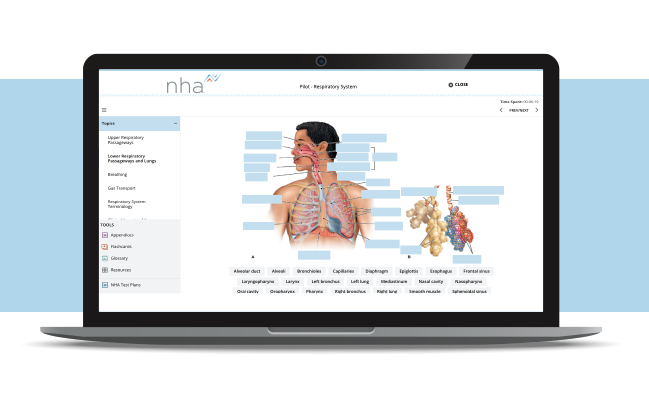In today’s world, many educators find themselves staring into the face of a computer screen rather than into the faces of their students. Determining whether your students are indeed present in class has become much more complicated as eye contact and body language can no longer serve as clues to a student’s level of attention, much less a student’s engagement.
Add to that the higher level of distraction as healthcare students try to juggle coursework and studying with domestic responsibilities, and the outcome looks grim.
When classes switched to online this past spring, more than 60% of 4,768 instructors interviewed by NHA said that keeping students engaged was a challenge. Additionally, with an absence of personal connection comes an absence of accountability, leaving students apt to drift.
COMMON OBSTACLES
An article in US News & World Report listed the following reported hindrances to online classes:
- Time management
- Distractions
- Lack of motivation
- Technical issues
- No interpersonal interaction
- Feeling uncertain about the future
How are instructors to keep their class tuned-in when learning is virtual (and feels virtually impossible)? The need for interactive, engaging learning solutions is key.
BREAK IT UP: Vary Your Teaching Methods
We recently held a webinar with several experienced healthcare educators who shared practical ideas for keeping your subject matter interesting (and your students interested). Here are some takeaways that you can start incorporating now to see increased student engagement:
- Have live sessions for asking questions and participating in discussions
- Use real world examples to keep students interested
- Give frequent quizzes to test knowledge retention
- Show videos to illustrate concepts
- Give assignments that allows students to express what they’ve learned
- Break up instructional time into shorter segments
- Have fun! (Use videos, animations, and other visually interesting items
INTERACTIVE TEACHING MATERIALS
We do our best to help educators attain positive outcomes by providing robust, online preparation materials, practice tests, and recording. With these convenient teaching materials, students can prepare for their exam regardless of their location.
While the convenience aspect of online test prep cannot be overlooked, many studies confirm that learning material that is interactive (and that requires more from the student than just silent reading) increases a student’s chances of overall retention.
“NHA certification preparation materials, in my opinion, are more engaging for students since they use a mix of video and interactive practice drills to help students focus on key concepts.” -- Rená Kuehler, instructor at Amarillo Area Center for Advanced Learning
ALLEVIATE THE STRUGGLE
To that point, did you know that some of the most challenging courses for healthcare students to plow through are the ones for medical terminology and anatomy & physiology? Within healthcare programs, these two courses are amongst the highest in fail and/or drop rates, which is especially concerning because they're foundational courses for nearly all healthcare profession programs.
Unfortunately, one of the primary reasons for low pass rates is credited to poor learning resources. Many of the tools available to educators today are segregated, tedious and lengthy, which can lead to low student engagement, retention and course completion. Because of our passion for allied healthcare workers and our desire to see them succeed, NHA has developed a solution to this frequent career-halting problem.

AN INNOVATIVE SOLUTION
We’ve just launched Medical Terminology, an interactive learning resource and textbook replacement that helps to keep students engaged in a course that is notorious for leaving healthcare student casualties in its wake. (We’re also tackling another big, foundational course this spring with our Anatomy & Physiology resource launch! More info coming soon.)
In our new, interactive courseware, you’ll find elements that increase student engagement, like:
- Animation videos
- Practice activities throughout
- Embedded audio pronunciation
- End-of-module quizzes
- Enrichments such as case studies, worksheets, and presentations.
- Simplified access within a single resource
In the same way that active learning complements an instructor’s lecture, so having an interactive learning resource complements the information within the book.
FREQUENT ASSESSMENT
Every teacher knows the importance of keeping tabs on what their students are comprehending and retaining. To keep students engaged and informed, you’ll want to keep checking students’ progress so there are no last-minute surprises. Exam day is not the ideal time for a student to realize that they’re ill-prepared!
The good news is that, if you’re using NHA’s preparation materials in your class, our built-in assessment tools allow instructors to see students’ progress as they advance through the courseware. (Surprisingly, many instructors aren’t aware of how detailed our unique, analytics-based measuring options are. If that’s you -- and you’d like a demo to better understand NHA’s P360 Vitals™ -- you can learn more here.) You’ll want to know how far your students are progressing through the course material, along with how they’re faring on their practice tests.
ENCOURAGEMENT + SUPPORT
As students in a virtual learning environment may struggle more than in traditional classrooms, the role of encouragement and support is paramount. By frequently checking in on your students’ progress using tools like our P360 Vitals™, educators will be able to tell if a normally on-track student starts to flounder. If your student reports show a drop in interactive participation, it can serve to alert you that there may be an access problem, or perhaps your student is feeling uncertain and starting to lose motivation.
While you as an educator can only do so much, having these metrics that allow you to gauge the progress of your students can let you know if you need to give some extra encouragement or provide a struggling student with some additional support.
 CAST VISION
CAST VISION
Stephen Lieb, in Principles of Adult Learning, states, “In order for participants to retain the information taught, they must see a meaning or purpose for that information.”
What does that mean? It means you remind your students why they’re doing what they’re doing.
One example of how to do that would be, when students are wading through tedious but foundational courses like medical terminology, you remind them that learning this new vocabulary is going to open the door to a whole new world. You keep the goal in front of them: They’re going to soon be in a healthcare career. It’s going to happen. They will be able to make a difference in the world doing something they love.
Whatever it is that motivates your students (and each one will be different), educators have to keep the end goal in front of their students, particularly as you collectively navigate the uncertain waters of distance learning in a global pandemic.
A WAY FORWARD
Despite the challenges faced by educators and students alike, healthcare institutions are counting on you – now more than ever – as the demand for nationally certified, skilled healthcare workers increases.
Fortunately, by getting creative in your teaching, having material that is interactive, paying attention to assessments and keeping your students encouraged and envisioned, educators have the tools needed to help meet that rising demand, all while, at the same time, helping your students access a better future. Keeping a high level of student engagement with motivated learners who are in it for the long run means everyone wins!




